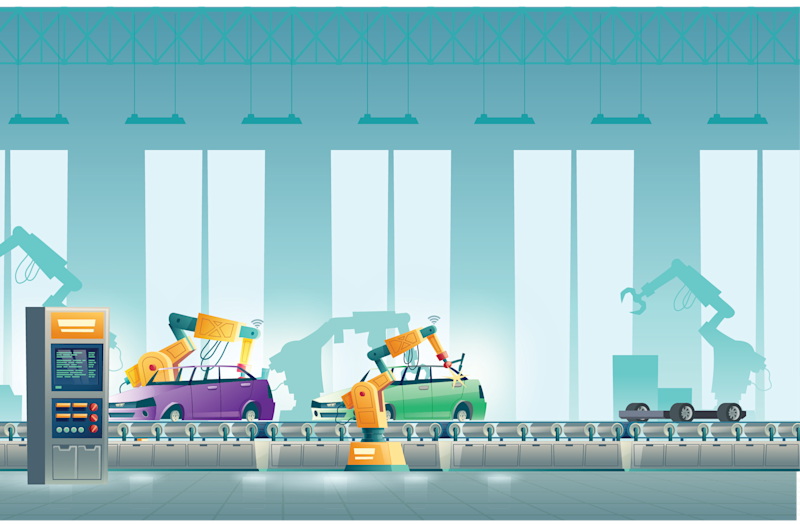The Digital at Bosch
Although you are undoubtedly familiar with Bosch, here are a couple of things that you don’t know about the company that employs some 395,000 people – 73,000 of whom are in research and development, which underscores the importance of technology to the firm:
Ninety-four percent of Robert Bosch GmbH is owned by Robert Bosch Stiftung GmbH. Why is that interesting? Because the latter is a charitable foundation.
The company was established in 1886 by, well, 25-year-old Robert Bosch, in Stuttgart, Germany, as the Workshop for Precision Mechanics and Electrical Engineering. While precision mechanics had been around for quite a while, it is worth putting 1886 into context: MIT didn’t establish its electrical engineering curriculum until 1882, and Technische Universität Darmstadt established an electrical engineering school in 1883. Bosch was clearly at the leading edge of technology.
Bosch today produces major home appliances, autonomous lawnmowers, e-bike drive systems, fuel injectors and fuel cells, and a wide variety more. What’s more, it makes equipment that it uses in its own factories to produce products, as well as provides it to others.
Consider vehicle batteries. Bosch has a plant in Eisenach, Germany, where it makes 48-volt batteries for hybrid vehicles. As Rolf Najork, a member of the Bosch board of management responsible for industrial technology, puts it, “We know batteries like the back of our hand, as well as how they have to be manufactured.”
Rather than holding that know-how close, Bosch is actually providing it to customers, such as Webasto, which operates a battery production operation in Schierling, Germany. Bosch provided automated assembly lines for welding and gluing the battery cells, which combine various functions (e.g., cell cleaning with incoming inspection, stacking, and laser welding).
Bosch is making extensive use of digital technologies in its operations, including Industry 4.0 technology that allows equipment to not only be networked but to optimize its capabilities in use. It has developed a manufacturing platform that combines software for production control, monitoring, and logistics planning. That, in turn, is connected to a larger database for purposes of analysis and fault detection.
Presently Bosch has more than 120,000 machines connected, as well as 250,000 other devices (e.g., robots and inspection systems). There are 22,000 machine controllers connected with an in-house-developed Industry 4.0 software, Nexeed (which is also offered to other companies, such as BMW).
What is it finding from its deployment of Industry 4.0?
Productivity increase of up to 25%
Machine availability increase of up to 15%
Maintenance cost reduction of up to 25%
While the company has some 250 plants, it selected one, the Feuerbach plant, as its Industry 4.0 lead operation. Notable about the plant is that it was actually established in 1909 by Robert Bosch, which makes it Bosch’s oldest plant. The facility, which is now a 1,174,342.63-square-foot operation, produces high-pressure pumps and components for automotive exhaust-gas treatment.
At the Feuerbach plant, there are some 550 machines connected. But they are taking connectivity to the next step, as it is also the Bosch lead operation for the deployment of 5G.
One of the places where 5G is being used to good effect in the factory is in material handling operations, where they have deployed the “Active Shuttle,” an autonomous carrier that is capable of avoiding people, inventory, equipment, and other vehicles in the factory as well as traveling to the spot on the production line where it needs to be to offload its supplies and then traveling back to where it can pick up more goods.
This is not a Germany-only deployment. At the Bosch facility in Charleston, South Carolina, for example, where there are some 1,600 associates specializing in advanced automotive products for the Bosch Mobility Solutions division, such as fuel injectors and electronic stability program modules for automotive braking systems, they are using artificial intelligence to prevent and detect any problems that could occur in manufacturing.
While [Deaville] thinks there will be growth in the production of end parts in the auto industry, he believes that lower-volume variants is where additive has the best potential. As Kai Woerner, the technical manager at the Bosch Charleston plant, puts it, “I4.0 is a key element of our manufacturing strategy. It supports not only our efforts to continuously improve our manufacturing and logistics processes but also to increase efficiency and reliability of all other plant functions.”
The Physical at Magna
Even among automotive suppliers, Magna is a special company, given that it has not only an extensive physical global footprint – 347 manufacturing operations; 90 product development, engineering, and sales centers in 28 countries; over 154,000 employees – but produces a diverse range of products, from lighting systems to active aerodynamic devices to seats to electrified powertrains. Who makes the hot-stamped steel inner and outer door rings used for the Acura RDX? Magna. The aluminum battery enclosures for the Ford F-150 Lightning? Magna.
What’s more, Magna has produced more than 3.7 million complete vehicles – such as the Mercedes G-Class, the Jaguar I-Pace, and the Toyota Supra. These and more have been manufactured at the Magna Steyr plant in Graz, Austria. The Fisker Ocean battery-electric SUV will be going into production at the Magna complex in Austria later this year.
The point is: If you want to talk to a company that is making everything from optics to mechatronics, from castings to moldings, a company that can make truck frames and electric vehicle powertrains, then Magna is going to be at the top of the list.
One of Everything
Given the wide range of production activities – and the realization that Magna just doesn’t make things to order but actually develops an extensive portfolio of products that are deployed by automotive OEMs – it isn’t entirely surprising to hear Todd Deaville, director, engineering and R&D, Magna, say “I think we, somewhere, have something representative of every additive process – in the big process categories, for sure.”
Deaville adds, “Magna is very decentralized. We use this equipment and processes wherever it makes sense. So I’ll walk into a division somewhere, and there will be a half-dozen additive machines running that I didn’t even know about.”
Magna is no stranger to additive manufacturing technologies. Indeed, Deaville says that some 20 years ago, the company built a system that was used for in-house tool repair. What’s more, he adds, “I think we had the first EOS machine in North America, 20-odd years ago.”
Three Things
One could make the case that there are three areas where additive technologies are used:
Prototyping (the original application, which gave rise to the term “rapid prototyping”)
Tooling development
Serial production
According to Deaville, at Magna, prototyping is where the use of systems began. “It is still a huge use case,” he says. “We have lots of machines doing engineering models and concept development all the time.” He believes this is an area where the technology will always play a role.
Tooling is something that they use additive for, and there is a variety of processes being used to produce components.
On this subject, Deaville notes, “It is probably a small percentage of our use of additive.” No, it isn’t the case because Magna doesn’t have an extensive range of tooling applications, but rather they “use the supply base.” In other words, he explains, suppliers generally keep up to date faster on some process areas than Magna can, so there is a tendency to use them.
Still, he concedes that it is “really good to have some equipment in house so that you know you have the capability, and it provides the capacity for quick turnarounds.”
This internal use of the technology has another important role, Deaville says. He thinks engineering design is absolutely important to have a handle on. The in-house equipment allows Magna personnel to keep up to speed on what additive allows in the way of design.
Specialization
Finally, serial production. “We are mostly in the high-volume world,” Deaville says. “So there is not so much applicability there.” Yet. While he thinks there will be growth in the production of end parts in the auto industry, he believes that lower-volume variants is where additive has the best potential. He cites, for example, the MINI Yours Customized product initiative from a few years back, where customers of MINI vehicles could design special trim components, such as dashboard trim strips and exterior side scuttle covers, that BMW would then produce. Specialized offerings like this carry a higher premium, so as automotive is highly price sensitive, the applicability of additive is different than, say, in aerospace, where they produce limited numbers of exceedingly high-value items, like nozzles for rockets.
Transitioning Capacity
However, as the auto industry is undergoing a transformation, there is more potential.
Not only is there the well-known shift to electrification, as well as increasing levels of driving automation, but also an influx of new manufacturers on the scene.
On the subject of the new entrants, Deaville rhetorically asks, “How do you provide components and products to these new customers? How do you mitigate those risks, challenges, and costs? It is easy to build a part if you know that you’re going to need a million of them. But if you need 200 today, and you don’t know how many you’re going to need tomorrow, that’s a different situation.”
As for electrification and automation, there are potential applications as well: Capital components that are designed, say, with integrated electronics that cannot be made another way could be where additive plays a bigger role.
In fact, Deaville thinks that the big breakthrough for additive will come not from the equipment or materials side but from the end-product side, from “a product that really needs this process, this technology. If someone finds that one …”
Then additive, even in automotive, will be a process just like milling and stamping.
And then there will be what’s next – the ongoing technological dynamic.






